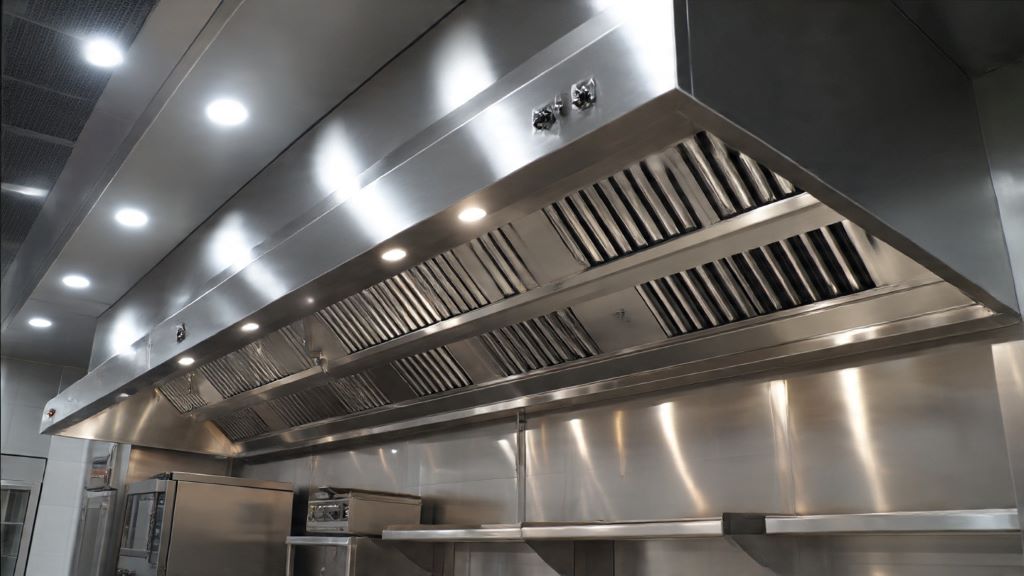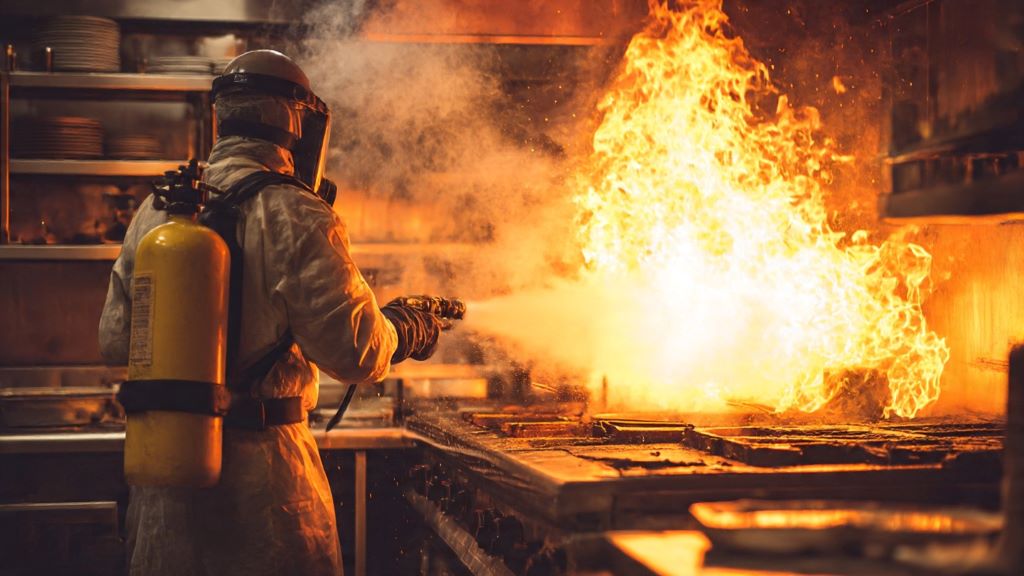When it comes to protecting commercial kitchens from fire hazards, understanding the right suppression method can save lives and property. Kitchen fires represent one of the most common and dangerous risks in the food service industry. According to Roof Master Construction, choosing the appropriate fire suppression technology is essential for meeting safety codes and protecting your investment. The debate between wet chemical and dry chemical systems has been ongoing for years, and each method offers distinct advantages depending on your specific needs.
Modern commercial kitchens face unique fire challenges that require specialized solutions. Grease fires burn at extremely high temperatures and can spread rapidly if not addressed properly. Traditional fire extinguishers often prove inadequate for these situations. Therefore, understanding the differences between wet and dry chemical suppression becomes crucial for anyone operating a commercial cooking facility.
Understanding Kitchen Fire Suppression Systems
A kitchen hood suppression system serves as the primary defense against cooking fires in commercial environments. These systems automatically detect flames and deploy fire suppression agents to extinguish the blaze before it spreads. Most modern installations integrate directly with the kitchen’s exhaust hood, providing targeted protection where fires most commonly start.
Fire suppression technology has evolved significantly over recent decades. Previously, many kitchens relied solely on dry chemical systems. However, changes in cooking equipment and safety regulations have prompted a shift toward wet chemical solutions in many applications. Each system type operates on different principles and offers varying levels of effectiveness depending on the cooking environment.
What Are Wet Chemical Fire Suppression Systems?
Wet chemical systems use liquid agents specifically formulated to combat grease fires. These solutions typically contain potassium acetate, potassium carbonate, or potassium citrate mixed with water. When deployed, the agent creates a chemical reaction with burning cooking oils and fats, forming a soapy foam that cools the fire and prevents reignition.
The suppression process works through a technique called saponification. This chemical reaction transforms hot grease into a non-combustible soap-like substance that effectively smothers the flames. Additionally, the water content in wet chemical agents provides excellent cooling properties, reducing the temperature of cooking surfaces below the auto-ignition point of oils and fats.
Installation of wet chemical systems involves strategically placing nozzles above cooking appliances. These nozzles connect to pressurized cylinders containing the suppression agent. When heat or flames trigger the detection system, the agent releases in a fine mist pattern that thoroughly covers the cooking surface without splashing burning grease.
What Are Dry Chemical Fire Suppression Systems?
Dry chemical systems utilize powdered agents to extinguish fires through a different mechanism. Common agents include monoammonium phosphate, sodium bicarbonate, or potassium bicarbonate. These powders work by interrupting the chemical reaction of combustion and creating a barrier between the fuel and oxygen.
When activated, dry chemical systems discharge powder at high velocity through nozzles positioned throughout the protected area. The powder cloud quickly envelops the fire, cutting off its oxygen supply and stopping the burning process. However, unlike wet chemicals, dry agents do not cool surfaces as effectively and may allow fires to reignite if hot oils remain at dangerous temperatures.
Historically, dry chemical systems dominated commercial kitchen fire protection. They proved effective for many years when cooking equipment operated at lower temperatures. Nevertheless, modern high-efficiency appliances generate significantly more heat, creating challenges that dry chemicals sometimes struggle to address adequately.
Key Differences Between Wet and Dry Chemical Systems
The primary distinction lies in how each system extinguishes fires and prevents reignition. Wet chemical agents cool cooking surfaces while simultaneously reacting with grease to create a suppression blanket. Dry chemicals primarily smother flames but provide limited cooling, potentially allowing fires to restart after initial suppression.
Cleanup requirements differ substantially between the two systems. Wet chemical residue typically washes away easily with water and mild detergent. Conversely, dry chemical powder creates extensive mess that requires thorough cleaning of all kitchen surfaces, equipment, and even adjacent areas. This cleanup difference can affect business downtime following a fire incident.
Environmental impact and equipment compatibility also vary. Wet chemical systems work effectively with modern high-temperature cooking appliances, including those using vegetable oils that burn hotter than animal fats. Dry chemical systems may prove less effective with these newer oil types, according to research from the National Fire Protection Association.
Advantages of Wet Chemical Systems for Kitchens
Wet chemical technology offers superior performance specifically designed for modern commercial cooking environments. The cooling effect prevents reignition even after the initial flames are extinguished. This feature provides critical safety advantages, especially in busy kitchens where staff may not immediately shut down all cooking equipment.
The chemical reaction between wet agents and cooking oils creates a lasting suppression effect. This soap-like barrier remains effective for extended periods, giving kitchen staff time to safely evacuate and fire departments time to arrive. Furthermore, the fine mist application minimizes splashing of hot grease, reducing the risk of spreading the fire or causing burns to nearby personnel.
Maintenance and inspection requirements for wet chemical systems often prove simpler than their dry counterparts. The liquid agents remain stable in their containers and do not settle or cake like some dry chemicals. Additionally, wet systems typically meet current fire safety codes and insurance requirements more readily than older dry chemical installations.
When Dry Chemical Systems Might Be Appropriate
Despite the advantages of wet chemical technology, dry systems still have valid applications in certain scenarios. Some industrial kitchens with specialized equipment or unique fire risks may benefit from dry chemical protection. Additionally, facilities with both kitchen and non-kitchen fire risks might choose dry chemical systems for broader coverage.
Cost considerations sometimes favor dry chemical systems for smaller operations or temporary kitchen setups. The initial installation expense may be lower, though long-term maintenance and potential cleanup costs should factor into the decision. However, most fire protection professionals recommend wet chemical systems for permanent commercial kitchen installations.
Older facilities with existing dry chemical systems may continue using them until replacement becomes necessary. Nonetheless, property owners should consult with fire safety experts about upgrading to wet chemical technology during renovations or equipment updates to ensure optimal protection and code compliance.
Installation and Maintenance Considerations
Proper installation requires professional expertise regardless of which system type you choose. Licensed fire protection contractors must design systems that meet local fire codes and National Fire Protection Association standards. The installation process involves careful calculations of coverage area, nozzle placement, and agent quantity needed for adequate protection.
Regular maintenance ensures system reliability when fires occur. Both wet and dry chemical systems require periodic inspections, typically every six months, by certified technicians. These inspections verify that cylinders maintain proper pressure, nozzles remain unobstructed, and detection systems function correctly.
Testing protocols differ between system types. Wet chemical systems often require annual agent replacement to maintain effectiveness, while dry chemical agents may last longer before replacement becomes necessary. However, the overall cost of ownership should consider not just maintenance but also potential damage and business interruption if a less effective system fails during an actual fire.
Making the Right Choice for Your Kitchen
Selecting between wet and dry chemical suppression depends on multiple factors specific to your operation. Consider the types of cooking equipment you use, the volume of food preparation, and the types of oils and fats in your kitchen. High-volume operations with modern appliances almost always benefit from wet chemical systems.
Budget constraints must be balanced against safety requirements and potential liability. While initial costs matter, the expense of inadequate fire protection far exceeds the price difference between system types. Insurance providers often offer reduced premiums for facilities with properly maintained wet chemical systems, offsetting some installation costs.
Consulting with fire protection professionals provides valuable guidance for making informed decisions. These experts can assess your specific risks, recommend appropriate equipment, and ensure installations meet all applicable codes and standards. Their experience helps prevent costly mistakes and ensures your kitchen receives adequate protection.
Conclusion
The choice between wet chemical and dry chemical fire suppression systems significantly impacts kitchen safety and operational efficiency. Wet chemical technology offers superior protection for modern commercial kitchens through effective cooling, chemical reaction with grease, and easier cleanup. While dry chemical systems served well in the past, they often fall short of today’s safety requirements and high-temperature cooking environments.
Investing in proper fire suppression protects lives, property, and business continuity. The enhanced effectiveness of wet chemical systems justifies their use in most commercial kitchen applications. By understanding these differences and working with qualified professionals, kitchen operators can implement fire protection strategies that provide peace of mind and meet evolving safety standards.
Frequently Asked Questions
What is the main advantage of wet chemical systems over dry chemical for kitchen fires?
Wet chemical systems cool cooking surfaces while creating a chemical reaction with grease that prevents reignition. This dual action provides superior protection compared to dry chemicals, which primarily smother flames without adequate cooling.
How often should a kitchen hood suppression system be inspected?
Professional inspections should occur every six months according to NFPA standards. Additionally, kitchen staff should perform visual checks monthly to ensure nozzles remain clean and system indicators show proper status.
Can I use a regular fire extinguisher instead of an automatic suppression system?
Building codes require automatic suppression systems for commercial kitchens. Portable extinguishers serve as supplementary protection but cannot replace proper hood suppression systems that activate automatically when fires occur.
How much does it cost to install a wet chemical suppression system?
Installation costs vary based on kitchen size, equipment configuration, and local requirements. Most commercial kitchens invest between three thousand and ten thousand dollars for complete systems, though larger facilities may require more extensive installations.
What happens to my kitchen after a suppression system activates?
Wet chemical systems leave residue that cleans relatively easily with water and detergent. However, all affected equipment requires thorough cleaning and inspection before resuming operations. Fire departments must also inspect the premises before you can reopen.
Related Topics:
Why Is Solo Stove Smoking? Tips And Tricks
Culinary Adventures: Kitchenware to Inspire Inner Chef





